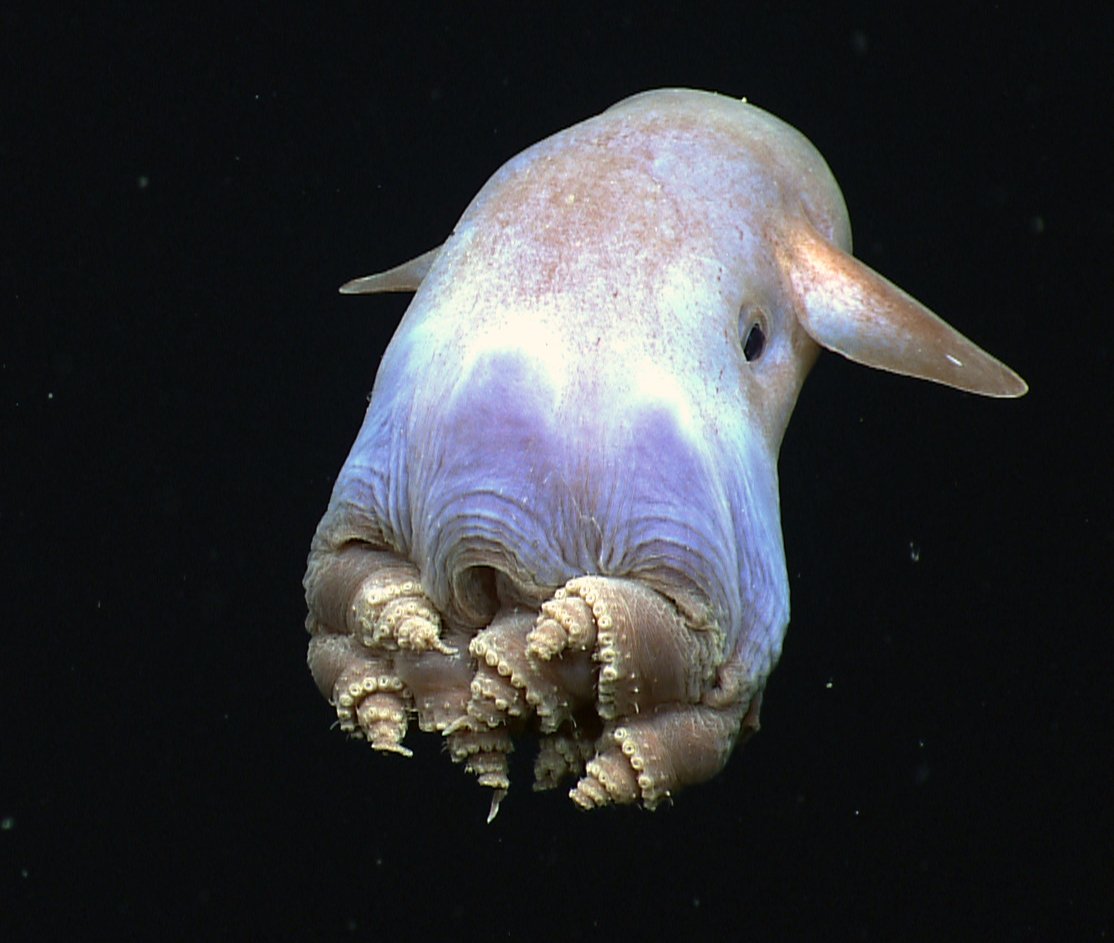The Creature Feature: 10 Fun Facts About the Dumbo Octopus
NOAA Okeanos Explorer, Public domain, via Wikimedia Commons.
It’s not often that an octopus is described as cute or whimsical. But dumbo octopuses have a certain squishy charm about them. With their large eyes and prominent, ear-like fins, they resemble the floppy-eared Disney elephant. But there is more to these elusive octopuses than just their adorable appearance. Read on to discover what else makes dumbo octopuses unique.
1. There are (at least) 17 species of dumbo octopus. The term “dumbo octopus” refers to an entire genus of finned, deep-sea octopuses. All 17 known species in the genus Grimpoteuthis are nicknamed “dumbo octopuses.”
2. Their bodies are soft and semi-translucent. Dumbo octopuses have squat, bell-shaped, semitranslucent bodies. Their looks are one thing that sets them apart from other octopuses, according to Jon Ablett, Senior Curator in Charge of Mollusca at the Natural History Museum in London. “They’re very blobby and gelatinous, which gives them an otherworldly alien-like look, especially when they’re brought up to the surface,” he says.
NOAA Ocean Exploration & Research, via Wikimedia Commons.
3. They are mostly on the small side. On average, dumbo octopuses grow to about 20-30 cm (7.9-12 inches) long. However, the largest specimen ever recorded was 1.8 m (70 inches) long and weighed 5.9 kg (13 pounds).
4. Dumbo octopuses live at extreme depths on the seafloor around the world. The deepest living of all known octopuses, Dumbos dwell in the frigid, dark waters of the bathyal zone and abyssal zone, thousands of meters below the ocean surface. In 2020, researchers spotted two dumbo octopuses in the Indian Ocean’s Java Trench at a depth of more than 6,000 m (20,000 feet) — the deepest confirmed sighting of these creatures.
5. They are blue-blooded. Like other octopuses, dumbos’ blood is blue due to hemocyanin, a copper-based protein. This protein is more efficient than iron-based hemoglobin at transporting oxygen in cold and low-oxygen environments.
NOAA OKEANOS EXPLORER Program, Gulf of Mexico 2014 Expedition, via Flickr.
6. Dumbo octopuses do not produce ink. Most octopuses squirt ink from their ink sacs to scare or confuse predators. With few predators in their deep-sea environment, Dumbos do not need this defense mechanism, and they do not have ink sacs.
7. Their suckers have sensory spines. Dumbo octopuses possess 60-plus suckers along each of their arms. These are lined with hair-like, spiny filaments called cirri. The cirri are thought to help the animals with sensing and sweeping food toward their mouths.
8. They swallow prey whole. Dumbos often hover just above the seafloor, ready to pounce on prey items, engulf them in their webbed arms, and swallow them whole. Their diet includes snails, worms, and small crustaceans.
NOAA OKEANOS EXPLORER Program, Oceano Profundo 2015; Exploring Puerto Rico's Seamounts, Trenches, and Troughs.
9. Dumbo octopuses don’t have a breeding season. Dumbos are rare and solitary, and the deep sea is enormous, so they must make the most of any encounters they have with the opposite sex. Female dumbos can store sperm for long periods of time after mating with a male. They also carry eggs in various stages of maturation within their mantles. When conditions are right, the female can transfer sperm to her most developed eggs and the lay the eggs under hard surfaces such as rocks or shells.
10. They are graceful swimmers.
Dumbos glide through the water by slowly flapping the ear-like fins that protrude from above their eyes. Since they are neutrally buoyant, they can drift passively with their fins expanded. Dumbo octopuses also extend and contract their arms, which are connected with webbing, to create a billowy umbrella shape to further aid movement. The result is surprisingly graceful, as you can see from this video.
References and Further Reading:
Bureau of Ocean Energy Management: Dumbo Octopus
MarineBio Conservation Society: Finned Deep-sea Octopuses.
Natural History Museum UK: Dumbo Octopus.
Price, Jo. “It swallows prey whole, can reproduce at any time and is named after a Disney character – meet this elusive deep-sea marine animal,” Discover Wildlife.




